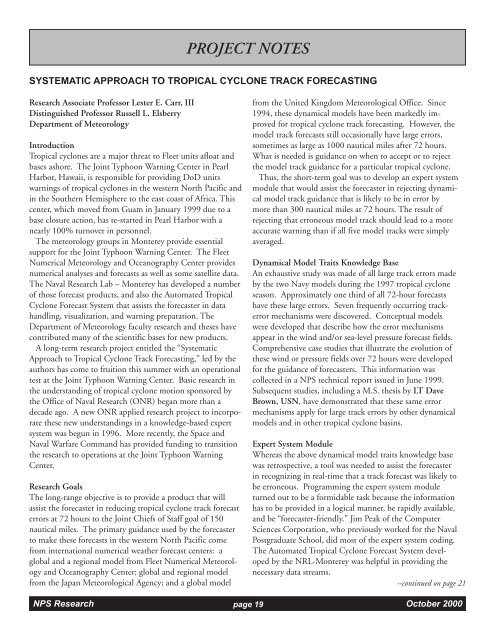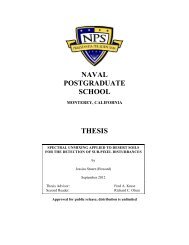October 2000 Newsletter - Naval Postgraduate School
October 2000 Newsletter - Naval Postgraduate School
October 2000 Newsletter - Naval Postgraduate School
Create successful ePaper yourself
Turn your PDF publications into a flip-book with our unique Google optimized e-Paper software.
PROJECT NOTES<br />
SYSTEMATIC APPROACH TO TROPICAL CYCLONE TRACK FORECASTING<br />
Research Associate Professor Lester E. Carr, III<br />
Distinguished Professor Russell L. Elsberry<br />
Department of Meteorology<br />
Introduction<br />
Tropical cyclones are a major threat to Fleet units afloat and<br />
bases ashore. The Joint Typhoon Warning Center in Pearl<br />
Harbor, Hawaii, is responsible for providing DoD units<br />
warnings of tropical cyclones in the western North Pacific and<br />
in the Southern Hemisphere to the east coast of Africa. This<br />
center, which moved from Guam in January 1999 due to a<br />
base closure action, has re-started in Pearl Harbor with a<br />
nearly 100% turnover in personnel.<br />
The meteorology groups in Monterey provide essential<br />
support for the Joint Typhoon Warning Center. The Fleet<br />
Numerical Meteorology and Oceanography Center provides<br />
numerical analyses and forecasts as well as some satellite data.<br />
The <strong>Naval</strong> Research Lab – Monterey has developed a number<br />
of those forecast products, and also the Automated Tropical<br />
Cyclone Forecast System that assists the forecaster in data<br />
handling, visualization, and warning preparation. The<br />
Department of Meteorology faculty research and theses have<br />
contributed many of the scientific bases for new products.<br />
A long-term research project entitled the “Systematic<br />
Approach to Tropical Cyclone Track Forecasting,” led by the<br />
authors has come to fruition this summer with an operational<br />
test at the Joint Typhoon Warning Center. Basic research in<br />
the understanding of tropical cyclone motion sponsored by<br />
the Office of <strong>Naval</strong> Research (ONR) began more than a<br />
decade ago. A new ONR applied research project to incorporate<br />
these new understandings in a knowledge-based expert<br />
system was begun in 1996. More recently, the Space and<br />
<strong>Naval</strong> Warfare Command has provided funding to transition<br />
the research to operations at the Joint Typhoon Warning<br />
Center.<br />
Research Goals<br />
The long-range objective is to provide a product that will<br />
assist the forecaster in reducing tropical cyclone track forecast<br />
errors at 72 hours to the Joint Chiefs of Staff goal of 150<br />
nautical miles. The primary guidance used by the forecaster<br />
to make these forecasts in the western North Pacific come<br />
from international numerical weather forecast centers: a<br />
global and a regional model from Fleet Numerical Meteorology<br />
and Oceanography Center; global and regional model<br />
from the Japan Meteorological Agency; and a global model<br />
from the United Kingdom Meteorological Office. Since<br />
1994, these dynamical models have been markedly improved<br />
for tropical cyclone track forecasting. However, the<br />
model track forecasts still occasionally have large errors,<br />
sometimes as large as 1000 nautical miles after 72 hours.<br />
What is needed is guidance on when to accept or to reject<br />
the model track guidance for a particular tropical cyclone.<br />
Thus, the short-term goal was to develop an expert system<br />
module that would assist the forecaster in rejecting dynamical<br />
model track guidance that is likely to be in error by<br />
more than 300 nautical miles at 72 hours. The result of<br />
rejecting that erroneous model track should lead to a more<br />
accurate warning than if all five model tracks were simply<br />
averaged.<br />
Dynamical Model Traits Knowledge Base<br />
An exhaustive study was made of all large track errors made<br />
by the two Navy models during the 1997 tropical cyclone<br />
season. Approximately one third of all 72-hour forecasts<br />
have these large errors. Seven frequently occurring trackerror<br />
mechanisms were discovered. Conceptual models<br />
were developed that describe how the error mechanisms<br />
appear in the wind and/or sea-level pressure forecast fields.<br />
Comprehensive case studies that illustrate the evolution of<br />
these wind or pressure fields over 72 hours were developed<br />
for the guidance of forecasters. This information was<br />
collected in a NPS technical report issued in June 1999.<br />
Subsequent studies, including a M.S. thesis by LT Dave<br />
Brown, USN, have demonstrated that these same error<br />
mechanisms apply for large track errors by other dynamical<br />
models and in other tropical cyclone basins.<br />
Expert System Module<br />
Whereas the above dynamical model traits knowledge base<br />
was retrospective, a tool was needed to assist the forecaster<br />
in recognizing in real-time that a track forecast was likely to<br />
be erroneous. Programming the expert system module<br />
turned out to be a formidable task because the information<br />
has to be provided in a logical manner, be rapidly available,<br />
and be “forecaster-friendly.” Jim Peak of the Computer<br />
Sciences Corporation, who previously worked for the <strong>Naval</strong><br />
<strong>Postgraduate</strong> <strong>School</strong>, did most of the expert system coding.<br />
The Automated Tropical Cyclone Forecast System developed<br />
by the NRL-Monterey was helpful in providing the<br />
necessary data streams.<br />
--continued on page 21<br />
NPS Research page 19<br />
<strong>October</strong> <strong>2000</strong>
















